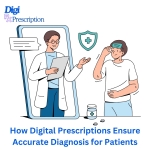
How Digital Prescriptions Ensure Accurate Diagnosis for Patients
Digital prescriptions are revolutionizing the healthcare industry by improving the accuracy of diagnoses and enhancing patient care. Traditional handwritten prescriptions often suffer from issues like illegibility, errors, and lack of comprehensive details. With digital solutions, doctors can minimize these risks, streamline their workflow, and provide patients with safer, more precise treatments. Let’s explore how digital prescriptions ensure accurate diagnosis and better healthcare outcomes.
1. Eliminating Errors from Handwritten Prescriptions
Handwritten prescriptions can be misinterpreted due to unclear handwriting or formatting, leading to incorrect treatments.
- Legibility:
Digital prescriptions are typed, eliminating the risk of misreading drug names, dosages, or instructions. - Standardization:
Predefined templates and formats ensure that all necessary details are included.
2. Integration with Drug Databases
Digital prescription software integrates with extensive drug databases to enhance diagnostic accuracy.
- Drug Suggestions:
The system can suggest appropriate medications based on the diagnosis, ensuring evidence-based treatment. - Drug Interactions Alerts:
Alerts notify doctors of potential drug interactions or contraindications, reducing the risk of adverse reactions.
3. Comprehensive Patient Records
Digital tools store and access patient history, enabling informed decision-making.
- Past Medical History:
Doctors can review previous diagnoses, treatments, and prescriptions to avoid redundant tests or conflicting medications. - Real-Time Data Access:
Access to up-to-date patient records ensures accurate and personalized care.
4. Diagnostic Support Features
Many digital prescription systems come equipped with diagnostic support tools.
- Symptom-Based Recommendations:
Tools analyze symptoms to suggest possible diagnoses. - AI-Powered Assistance:
Advanced systems use artificial intelligence to cross-reference symptoms with large datasets for precise diagnosis.
5. Reduced Risk of Miscommunication
Digital prescriptions minimize errors caused by miscommunication between doctors, pharmacists, and patients.
- Clear Instructions:
Dosage, frequency, and duration are clearly mentioned, reducing confusion for pharmacists and patients. - Language Customization:
Some tools allow instructions to be provided in the patient’s preferred language, enhancing understanding.
6. Enhancing Follow-Up and Monitoring
Digital systems enable better follow-up care and monitoring, contributing to accurate diagnosis over time.
- Treatment Tracking:
Doctors can monitor how patients respond to prescribed treatments and make adjustments if necessary. - Alerts and Reminders:
Automated reminders for follow-up visits ensure that conditions are properly managed.
7. Enabling Data-Driven Insights
Digital prescriptions generate valuable data that can be analyzed to improve diagnosis accuracy.
- Pattern Recognition:
Systems can identify trends and patterns in patient symptoms for more accurate diagnoses. - Research Integration:
Doctors can access the latest research and guidelines directly through the platform.
Conclusion
Digital prescriptions are more than just a modern replacement for pen-and-paper methods—they are powerful tools that enhance diagnostic accuracy, reduce errors, and improve patient outcomes. By integrating patient history, drug databases, and diagnostic support, these systems help doctors provide safer and more effective care. As healthcare continues to embrace digital transformation, the adoption of digital prescriptions will play a pivotal role in improving diagnosis and treatment.
